July 28, 2024
All Eyes on Tahiti: An Olympic Wave
Tahiti Hosts the 2024 Olympic Surfing Competition
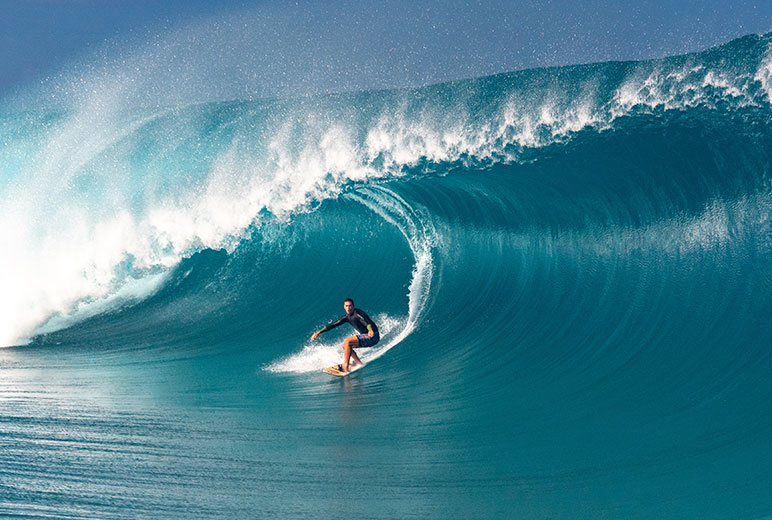 Iconic, majestic, and now… Olympic. Tahiti’s legendary Teahupo’o will welcome 48 surfers from 21 countries to the 2024 Summer Olympic Games, all aiming to catch a wave that will carry them to gold.
Iconic, majestic, and now… Olympic. Tahiti’s legendary Teahupo’o will welcome 48 surfers from 21 countries to the 2024 Summer Olympic Games, all aiming to catch a wave that will carry them to gold.
“For those not familiar with the latest craze to invade the sun-drenched Pacific coast of Southern California, here is a definition of “surfing”– a water sport in which the participant stands on a floating slab of wood, resembling an ironing board in both size and shape, and attempts to remain perpendicular while being hurtled toward the shore at a rather frightening rate of speed on the crest of a huge wave (especially recommended for teen-agers and all others without the slightest regard for either life or limb).” ~ Sleeve notes from Surfin’ Safari, 1962; Beach Boys
Oh those darling crooners of 60’s surf culture sure did know how to poke a little fun at the emerging popularity of the sport that gave their music its enduring allure. All tongue-in-cheek humor aside, surfing’s standing on the global stage has come a long way from Gidget movies and Spicoli’s character in Fast Times at Ridgemont High. On July 27, 2024, the sport made its second Olympic appearance, turning all eyes from the XXXIII Olympiad’s host city of Paris to a legendary wave called Teahupo’o (cho-poo) in Tahiti.
The Birthplace of Surfing
To understand the profound significance of the Olympic surfing competition taking place here, we have to go back to the origins of the sport. It’s likely that the “riding of waves” has existed since humans began swimming in the ocean. But experts generally agree that surfing dates back to 12th century Polynesia where cave paintings illustrate ancient versions of people surfing.
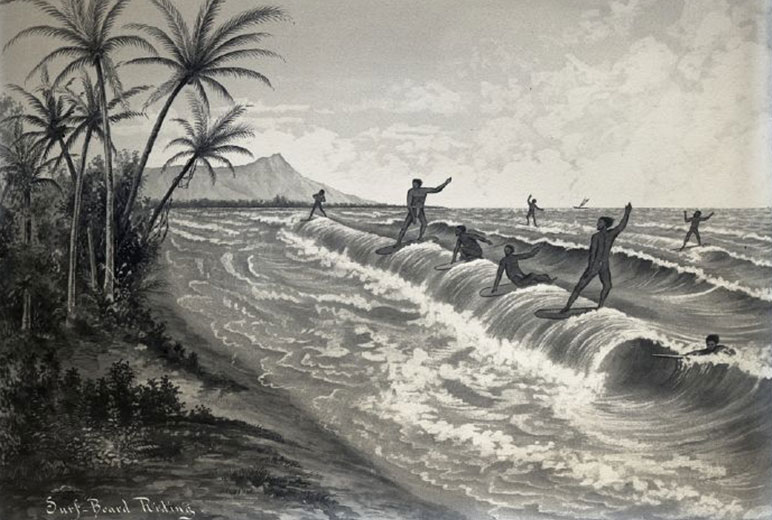 The seafaring Polynesians brought the art of surfing to Hawaii where it became known as he’e nalu—literally, wave sliding.
The seafaring Polynesians brought the art of surfing to Hawaii where it became known as he’e nalu—literally, wave sliding.
Throughout all Polynesia, surfing was a way of life with a deep religious significance including ceremonies to seek the goodwill of the gods (talk to any modern-day surfer and their rhapsodies of the perfect wave is a near-religious experience for them too!). Everybody surfed—men, women, children, kings—and there were strict rules regulating who could surf which spot (this possessive aspect of surfing still lingers, so it’s always a good idea to share a friendly la orana—hello—when dropping in). There was always a hierarchy in the sport, with the best boards reserved for royalty, the ari’i (chiefs), and members of the ruling class.
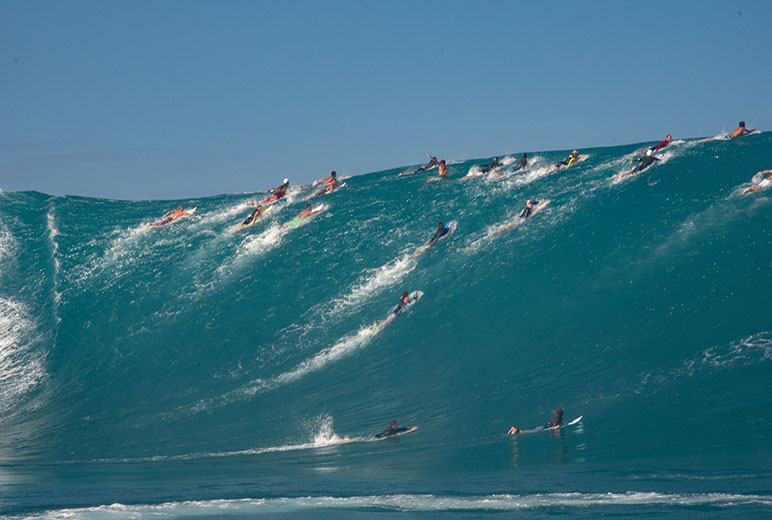 It takes strength, fortitude, and endurance for surfers to paddle out over giant swells to join the line-up and drop into one of Teahupo’o’s famous barrels.
It takes strength, fortitude, and endurance for surfers to paddle out over giant swells to join the line-up and drop into one of Teahupo’o’s famous barrels.
The Tahitians and Samoans would also use surfing as a way to train their warriors for battle. How so, you ask? Try paddling out over the soaring shore breaks to patiently wait for the perfect swell. Before you can catch a wave, you have to get to the wave, and that requires significant strength and endurance. Surfing is the oldest sport practiced in Tahiti and remains an essential part of their ancestral traditions, preserving a cultural bond between people and the ocean.
First Wave to Global Phenomenon
Surf historians credit English botanist Joseph Banks as the first person to spot someone surfing in Tahiti while sailing aboard the Endeavour in 1769 under the command of Captain James Cook. Recalling the experience, Cook would go on to record in his journal: “I could not help concluding that this man felt the most supreme pleasure while he was driven on so fast and so smoothly by the sea.”
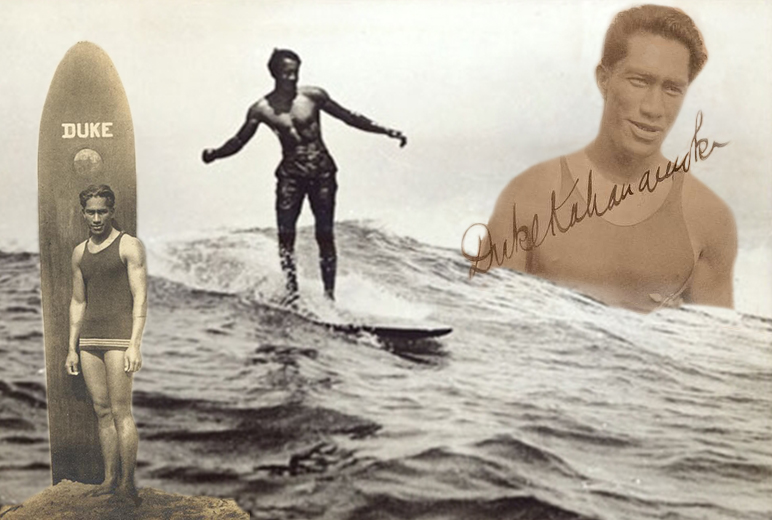 Duke Paoa Kahinu Mokoe Hulikohola Kahanamoku (1890-1968), aka “The Duke,” was a Hawaiian-born Olympic swimming medalist who introduced surfing to the world in the early 1900s.
Duke Paoa Kahinu Mokoe Hulikohola Kahanamoku (1890-1968), aka “The Duke,” was a Hawaiian-born Olympic swimming medalist who introduced surfing to the world in the early 1900s.
It's impossible to talk about the history of surfing without mentioning Duke Kahanamoku, born in Hawaii in 1890 and renowned as the father of modern surfing. A five-time swimming medalist in the 1912, 1920, and 1924 Olympics, “The Duke,” as he was known, had a deep passion for the waves and became the best surfer of his generation. At the time, surfing was almost unheard of outside of Hawaii and he embarked on a global tour to introduce “the sport of kings” to the world.
Today, as Tahitian locals Kauli Vasst and Vahine Fierro—joined by Carissa Moore (2021 Olympic gold medalist), Caroline Marks, Caity Simmers, Griffin Colapinto, and John John Florence representing the United States—prepare to ride Teahupo’o in search of gold, they can thank The Duke for bringing their sport to the world stage over 100 years ago.
About Teahupo'o
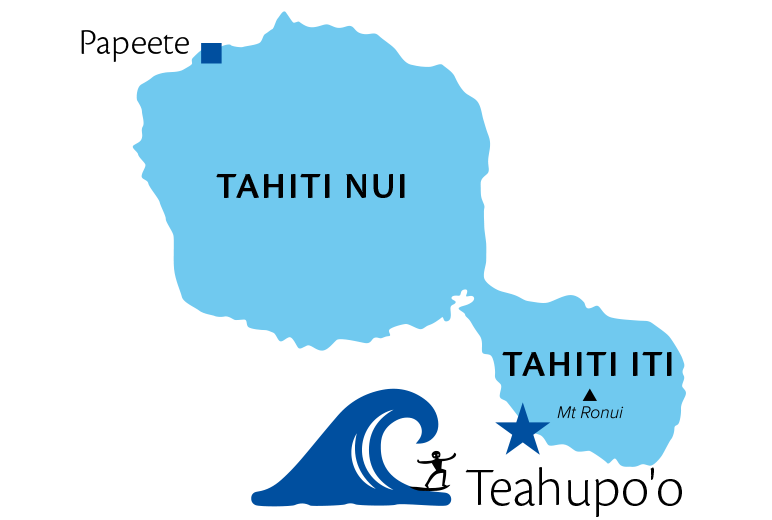 The village of Teahupo’o (population 1,455) is often called “The End of the Road” in the surfing community; located at mile marker 0 on Tahiti Iti (little Tahiti), the smaller part of Tahiti’s 8-shaped geography that is connected by the isthmus of Taravao.
The village of Teahupo’o (population 1,455) is often called “The End of the Road” in the surfing community; located at mile marker 0 on Tahiti Iti (little Tahiti), the smaller part of Tahiti’s 8-shaped geography that is connected by the isthmus of Taravao.
Located on the southwestern shores of Tahiti, Teahupo’o is a small village known for its legendary surf breaks. But don’t let the dreamy vision of waves lapping on the shore of paradise fool you, for this is no ordinary wave. In fact, its name quite literally translates to “sever the head” or “place of skulls.” A little extreme you say? In the words of Tahitian pro surfer Michel Bourez, Teahupo’o “is one of the best and scariest waves you could ever surf.” Local water patrol and surfer Aresene Harehoe adds that “the wave is really dangerous, you know, you can die out there.”
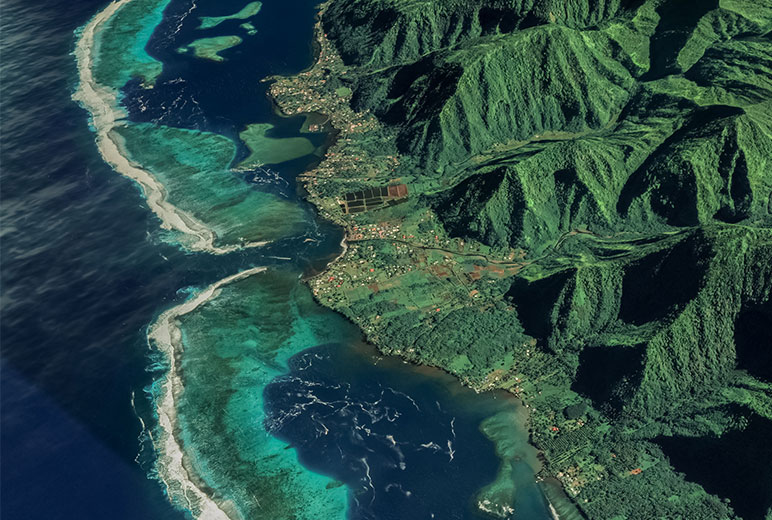 Unrivaled in beauty, the waves at Teahupo’o are a unique combination of size, power, and speed made all the more dangerous as they break over a sharp coral reef just six feet below the surface.
Unrivaled in beauty, the waves at Teahupo’o are a unique combination of size, power, and speed made all the more dangerous as they break over a sharp coral reef just six feet below the surface.
The first person to ride TChops, or Chopes as the wave is known, was Tahitian surfer Thierry Vernaudon who with a few other locals christened Teahupo'o as a surf spot in 1985. It is considered the most famous reef break in the world and a “must-surf” for experienced surfers. Teahupo'o is renowned for its powerful, glassy waves that average 10 to 15 feet (sometimes in excess of 25 feet) and for the consistent number of barrels it delivers. Barrel riding, known also as tube riding, is considered the holy grail of surfing—when the surfer gets inside the wave and rides through the tube with the goal of being spit out the other side.
Teahupo’o is commonly referred to as the heaviest wave in the world. A heavy wave has a thick lip (the top curl) and a lot of water behind it (more water = more power). The heaviness of the wave is created because of the change in depth on the sea floor. About 160 feet beyond the shallow reef, the sea floor drops to more than 50 feet. This means the swells coming towards shore change from very deep water to extremely shallow water over a short distance in a short period of time. This causes the wave to rise up over the reef before crashing down.
An Olympic Wave
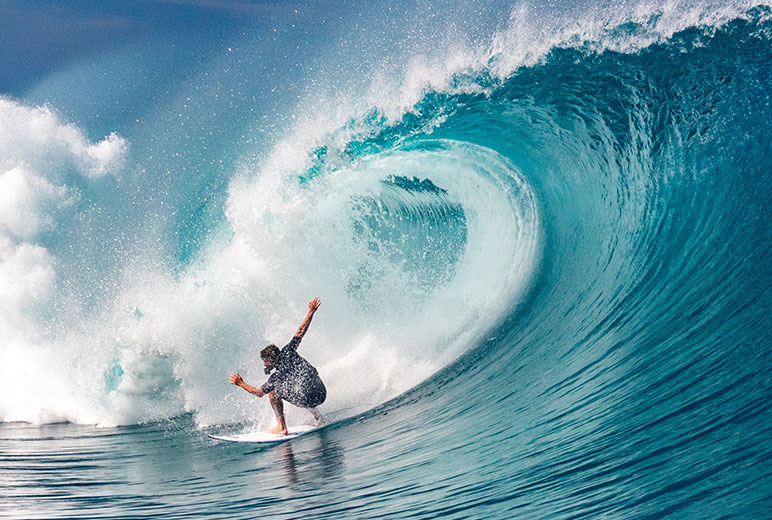
Since 1999, the annual Billabong Pro Tahiti surf competition has been hosted here, part of surfing’s World Championship Tour. It is the ultimate test of a surfer’s commitment and barrel-riding ability and in less than two weeks, Teahupo’o will test the mettle of the world’s greatest surfers. Witness nature's majesty and man's unshakeable resolve as world-renowned surfers descend upon the shores of Teahupo’o to face one of the most dangerous and daring paddle-out of their lives in hopes of bringing home that gold in honor of man and motherland in this year's Olympic Games. Sounds like the Beach Boys were on to something after all.
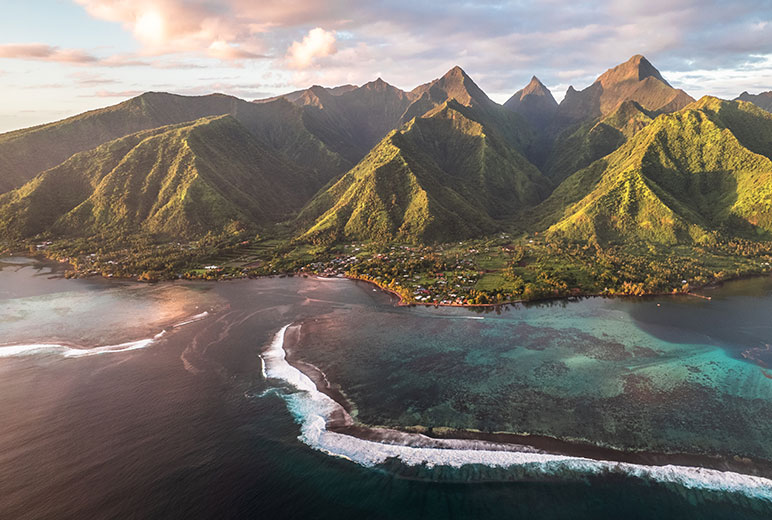 Add a pre- or post-cruise resort package in Tahiti to your French Polynesian voyage with Paul Gauguin Cruises and set your eyes (if not your surfboards!) on the beauty of Teahupo’o, about a 1.5-hour drive from Papeete.
Add a pre- or post-cruise resort package in Tahiti to your French Polynesian voyage with Paul Gauguin Cruises and set your eyes (if not your surfboards!) on the beauty of Teahupo’o, about a 1.5-hour drive from Papeete.
While surfing Teahupo’o’s fierce swells may not be an excursion offered by Paul Gauguin Cruises, the water sports available aboard the m/s Paul Gauguin do provide for immersive discovery of the fabled waters found throughout French Polynesia. Book today and join us on an all-inclusive luxury voyage featuring complimentary paddleboarding and kayaking directly from the ship’s marina, or embark on optional snorkeling and SCUBA adventures among the marine-rich coral reefs and brilliant lagoons found from Tahiti to the Tuamotus.
Where It All Began: Teahupo'o & the History of Surfing
(A Tahiti Tourisme Video)
PGC Blog ID 77424We